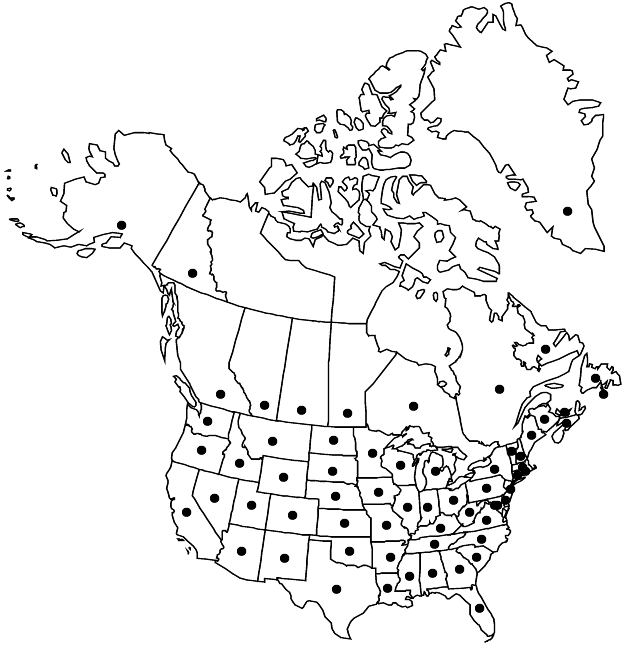Difference between revisions of "Persicaria maculosa"
Nat. Arr. Brit. Pl. 2: 269. 1821.
FNA>Volume Importer |
FNA>Volume Importer |
||
| Line 11: | Line 11: | ||
|name=Polygonum persicaria | |name=Polygonum persicaria | ||
|authority=Linnaeus | |authority=Linnaeus | ||
| + | |rank=species | ||
|publication_title=Sp. Pl. | |publication_title=Sp. Pl. | ||
|publication_place=1: 361. 1753 | |publication_place=1: 361. 1753 | ||
| Line 17: | Line 18: | ||
|name=Persicaria fusiformis | |name=Persicaria fusiformis | ||
|authority=(Greene) Greene | |authority=(Greene) Greene | ||
| + | |rank=species | ||
}} {{Treatment/ID/Synonym | }} {{Treatment/ID/Synonym | ||
|name=Persicaria vulgaris | |name=Persicaria vulgaris | ||
|authority=Webb & Moquin-Tandon | |authority=Webb & Moquin-Tandon | ||
| + | |rank=species | ||
}} {{Treatment/ID/Synonym | }} {{Treatment/ID/Synonym | ||
|name=Polygonum fusiforme | |name=Polygonum fusiforme | ||
|authority=Greene | |authority=Greene | ||
| + | |rank=species | ||
}} {{Treatment/ID/Synonym | }} {{Treatment/ID/Synonym | ||
|name=Polygonum persicaria var. ruderale | |name=Polygonum persicaria var. ruderale | ||
|authority=(Salisbury) Meisner | |authority=(Salisbury) Meisner | ||
| + | |rank=variety | ||
}} {{Treatment/ID/Synonym | }} {{Treatment/ID/Synonym | ||
|name=Polygonum puritanorum | |name=Polygonum puritanorum | ||
| − | |authority= | + | |authority= |
| + | |rank=species | ||
}} | }} | ||
|hierarchy=Polygonaceae;Polygonaceae subfam. Polygonoideae;Persicaria;Persicaria sect. Persicaria;Persicaria maculosa | |hierarchy=Polygonaceae;Polygonaceae subfam. Polygonoideae;Persicaria;Persicaria sect. Persicaria;Persicaria maculosa | ||
| Line 54: | Line 60: | ||
-->{{#Taxon: | -->{{#Taxon: | ||
name=Persicaria maculosa | name=Persicaria maculosa | ||
| − | |||
|authority=Gray | |authority=Gray | ||
|rank=species | |rank=species | ||
| Line 70: | Line 75: | ||
|publication year=1821 | |publication year=1821 | ||
|special status= | |special status= | ||
| − | |source xml=https://jpend@bitbucket.org/aafc-mbb/fna-data-curation.git/src/ | + | |source xml=https://jpend@bitbucket.org/aafc-mbb/fna-data-curation.git/src/f50eec43f223ca0e34566be0b046453a0960e173/coarse_grained_fna_xml/V5/V5_1208.xml |
|subfamily=Polygonaceae subfam. Polygonoideae | |subfamily=Polygonaceae subfam. Polygonoideae | ||
|genus=Persicaria | |genus=Persicaria | ||
Revision as of 22:51, 16 December 2019
Plants annual, (0.5–)1–7(–13) dm; roots also often arising from proximal nodes; rhizomes and stolons absent. Stems procumbent, decumbent, ascending, or erect, simple or branched, without obvious ribs, glabrous or appressed-pubescent. Leaves: ocrea light brown, cylindric, 4–10(–15) mm, chartaceous, base inflated, margins truncate, ciliate with hairs 1–3.5(–5) mm, surface glabrous or strigose, rarely with spreading hairs, not glandular-punctate; petiole 0.1–0.8 cm, glabrous or strigose, leaves sometimes sessile; blade often with dark triangular or lunate blotch adaxially, lanceolate to narrowly ovate, (1–)5–10(–18) × (0.2–)1–2.5(–4) cm, base tapered or cuneate, margins antrorsely strigose, apex acute to acuminate, faces glabrous or strigose, especially along midveins, sometimes glandular-punctate abaxially. Inflorescences terminal and axillary, erect, usually uninterrupted, 10–45(–60) × 7–12 mm; peduncle 10–50 mm, glabrous or, rarely, pubescent; ocreolae overlapping or sometimes interrupted proximally, margins ciliate with bristles 0.2–1.3(–2) mm. Pedicels ascending, 1–2.5 mm. Flowers 4–14 per ocreate fascicle, homostylous; perianth greenish white proximally and roseate distally or entirely roseate, not glandular-punctate, scarcely accrescent; tepals 4–5, connate ca. 1/3 their length, obovate, 2–3.5 mm, veins prominent, not anchor-shaped, margins entire, apex obtuse to rounded; stamens 4–8, included; anthers yellow or pink, ovate; styles 2–3, connate proximally. Achenes included or apex exserted, brownish black to black, discoid or biconvex to 3-gonous, (1.9–)2–2.7 × (1.5–) 1.8–2.2 mm, shiny, smooth. 2n = 44.
Phenology: Flowering Mar–Nov.
Habitat: Weedy, moist semiwaste to cultivated areas
Elevation: 0-2500 m
Distribution

Greenland, St. Pierre and Miquelon, Alta., B.C., Man., N.B., Nfld. and Labr., N.S., Ont., P.E.I., Que., Sask., Yukon, Ala., Alaska, Ariz., Ark., Calif., Colo., Conn., Del., D.C., Fla., Ga., Idaho, Ill., Ind., Iowa, Kans., Ky., La., Maine, Md., Mass., Mich., Minn., Miss., Mo., Mont., Nebr., Nev., N.H., N.J., N.Mex., N.Y., N.C., N.Dak., Ohio, Okla., Oreg., Pa., R.I., S.C., S.Dak., Tenn., Tex., Utah, Vt., Va., Wash., W.Va., Wis., Wyo., Eurasia, Africa, Pacific Islands (New Zealand).
Discussion
An allozyme study by L. L. Consaul et al. (1991) provided evidence of the allotetraploid origin of Persicaria maculosa, with P. lapathifolium as one of the parents. Plants with stems spreading-hairy and peduncles stipitate-glandular have been named P. maculosa subsp. hirsuticaulis (Danser) S. Ekman & Knutsson. Material referable to this subspecies has not been seen among North American specimens. Hybrids between P. maculosa and P. minor have been documented in Europe (R. H. Roberts 1977).
The Cherokee, Chippewa, and Iroquois prepared simple or compound decoctions of Persicaria maculosa, which they used as dermatological, urinary, gastrointestinal, and veterinary aids, for heart medicine, and as an analgesic (D. E. Moerman 1998).
Selected References
None.